| Home |
| Acknowledgments |
| Conventions |
| Glossary |
| Maps |
| References |
| Links |
| Articles |
| Thumbnails |
| Species
list |
| Family |
| Next
species |
Additional Photos
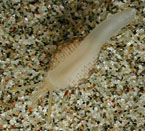
underside

front
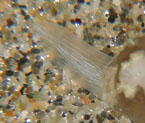
foot detail

young
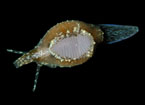
transitional
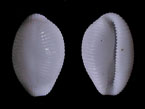
shell

shell size
_______________
GALLERY

Trivirostra hordacea (Kiener, 1845)
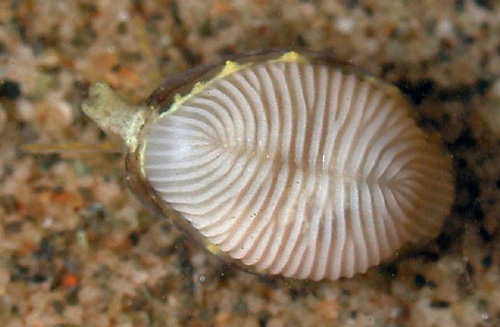
| Maximum size: 7 mm shell length (Severns, 2011). Identification: In mature animals, the mantle is light brown flecked with yellow-white and darker brown. It's studded with simple tubercles tipped with yellow (more prominent near the mid-line). The body is translucent cream and its upper surface is irregularly striated with white. Shells are white and typically smaller (and with a lower profile) than in the similar-appearing Trivirostra edgari. The apical margin is usually straight to slightly convex. Size at maturity is variable (3-7 mm shell length based on my material and Severns, 2011). Natural history: Trivirostra hordacea is a moderately common species in moderately exposed to exposed rocky habitats and Halimeda kanaloana beds from 3-30 m (10-98 ft). Distribution: Big Island, Maui, Oahu, Kauai and Maro Reef: widely distributed in the Indo-Pacific. Taxonomic notes: It's listed in Kay, 1979, as Trivia hordacea. It may also be listed in Kay, 1979 as Trivia pellucidula. (Note 1) In addition, it may be listed in Severns, 2011 as Trivirostra cf. hyalina, Trivirostra ginae, Trivirostra sp., Trivirostra shawi and Trivirostra thaanumi. (Note 2) Photo: CP: Maalaea Bay, Maui; April 26, 2003. Observations and comments: Note 1: The primary difference between T. hordacea and T. pellucidula as discussed and illustrated in Kay, 1979, is the absence of a dorsal sulcus in the latter. Otherwise, they seem identical. Since the dorsal sulcus appears to develop as the animal matures in T. hordacea and maturity occurs over a wide size range it seems likely that Hawaiian shells attributed to T. pellucidula are actually slightly immature T. hordacea. This is not intended to address the question of whether or not the material in the original description is distinct. (see photo) Note 2: We have seen many living animals of both T. hordacea and T. edgari with the characteristics of the living animals being consistent. We have not seen any animals that would suggest the presence of other species in the genus. Shells are much more ambiguous. Both species show a wide size range at maturity with some overlap. (see photo) And, they show substantial variation based on ontogeny and size at maturity. Therefore, it seems more parsimonious to assign the Hawaiian material to two variable species rather than to a multitude of more narrowly defined species as suggested by Severns, 2011. We have tentatively assigned the illustrations in that source to either T. hordacea or T. edgari based on their dorsal margins, profiles and axial sculpture. Again, this is not intended to address the question of whether or not the material in the original descriptions of those species is distinct. |
| Thumbnails |
Species
list |
Family | Next species | Top |